Day 5: Baldwinsville to Fulton
Sunday, August 8, 1999
It seems that not everybody at the terminal wall in Baldwinsville was
in transit. The boat two behind us consisted of men who went out
drinking. Later, their girls came to the boat and they all had a
party that lasted until after 1:00 a.m. Two boats were involved.
They let off a bunch of people around 1:10 a.m. (who were talking loudly
as they went away), then roared out of there at a drunken high speed.
There were mosquitoes, but they werenít too bad. It rained during
the night and continued as intermittent rain during the morning.
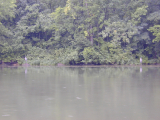 |
Two herons. | |
 |
Crew practicing. |
|
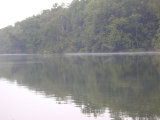 |
Mist. | |
 |
Reflections. |
|
At Three Rivers, the Seneca River and the Oneida River join to form the
Oswego River. Historically, this was an important meeting place.
The Iroquois Indians probably used it as such. During the French
and Indian War, the British built a small fort there. During the
Revolutionary War, British forces met there before proceeding to attack
Fort Stanwix (unsuccessfully).
 |
Three Rivers. | |
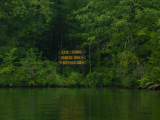 |
Sign about the junction. Notice that only two out of the three directions are mentioned |
|
We turned to take a side trip part way down the Oswego River, which
is also the Oswego Canal. The original Oswego Canal was usually adjacent
to the river and had a towpath next to it. It had eighteen locks
and went from Oswego south to Syracuse, where it joined the Erie Canal.
It was started in 1826 and completed two years later. It was originally
four feet deep, as was Clintonís Ditch. Later, its depth was increased
to ten feet. The present day Oswego River/Canal has seven locks,
numbered 1, 2, 3, 5, 6, 7, and 8! (As construction proceeded, engineers
realized that Lock 4 wasnít needed. Plans were drawn by hand.
It was easier to leave out a number than to renumber the others.)
The depth of the canal is approximately fourteen feet. It flows twenty-four
miles north to Oswego and Lake Ontario.
The River was wide and serene. Some very large houses built along
the bank in places. Other parts were quite rural.
We locked through Lock 1 (lift 10.2 feet) at Phoenix. This area
was originally a portage route. Fulton was another major portaging
place on the Oswego River.
Lock 2 (lift 17.8 feet), nine miles downstream, in Fulton was difficult.
The lockmaster didnít answer our VHF call. Eventually, there were
five large northbound boats piled up behind us; a sixth entered the lock
with us later. It was quite windy. It was difficult to hold
onto wall before the lock, and to maintain proper boiler pressure.
After the lock filled, ten southbound boats emerged from of the lock.
I guess the lockmaster didnít have time to answer our call.
We ran low on wood in the firebox because the lockage took so long.
The cables inside the lock were placed so far apart we couldnít reach two
adjacent ones easily. Al held the boat in the center. North of the
lock, there was a stiff headwind and we had little fuel burning.
He put some more wood in the firebox. The navigational channel was
very narrow and the other boats, which were very tall and were being buffeted
by the wind, had to keep in line behind us. Also, as we emerged from
the lock, two southbound boats were having some difficulty keeping out
of the way of the exiting northbound boats. This was our least enjoyable
experience with locks.
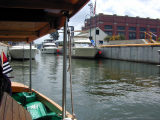 |
Lock 2. | |
 |
Lock 2 gate (right). |
|
Canalview Marina was hiding away just before Lock 3, a scant half mile
downstream from Lock 2. We pulled in there around a quarter after
one. Although the marina rarely has an attendant present, the wood
we had stored there was untouched.
The last day of a jazz festival in town was just ending. At least
it gave us portapotties to use. The Port-A-John, incidentally, was
invented in Fulton.
We had a mid-afternoon lunch of submarine sandwiches at Mama Ginoís.
Al needed some filters for the steamboat, so he set off for a NAPA store
that turned out to be more like a mile away, rather than the half mile
that had been stated. The store closed at two. Al got
there around a quarter to four, but the owner happened to be waiting to
meet someone at four, so he sold Al the filters and some Locktite.
In the meantime, our friends Ginny and Abby arrived, so we chatted for
a while. They brought with them some fresh baked cookies and apple
bread. How nice!
When Al returned, we all got the wood onto the boat. Ginny commandeered
a handtruck from someone who was helping with the jazz festival.
He had once tried to borrow $10 from her to buy a marriage license, because
the price had gone up since the last time he had gotten married.
 |
Abby and Ginny. | |
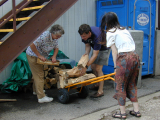 |
Ginny, Al, and Abby loading wood onto handtruck. |
|
We drove to the Golden Corral, which Dave and Barbara had recommended highly
to us. To our astonishment, they were there, too! When we had
left them yesterday morning, they had been planning to go to an antique
boat show in Clayton. Soon after that, they changed their minds and
decided to go to a steamboat meet in Kingston. On their way back,
they were planning to eat in a certain Ponderosa Restaurant, but found
that it had been changed into a Chinese restaurant. So they drove
on to Fulton. En route, they checked with the lockmasters at Locks
1 and 2 to see if a steamboat had gone through. Each time, they talked
with one who had just gone on his shift, so he didnít know. They
looked at the terminal wall, but we werenít there. So everybody was
surprised when we met up at the Golden Corral! Dinner was delicious,
and there was a tremendous choice of foods to eat. Everybody got
along beautifully, with much discussion of the history of areas around
Fulton.
After dinner, we got a few groceries, then headed back to our boat.
Someone finally showed up to take our money. We got a key to the
bathroom and shower. The shower sure felt great!
I think I saw more many great blue herons today than I had ever seen
before in one day.
At dusk, we were treated to a sunset.
Number of locks: 3
Approximate distance for day: 20 miles
Next day Previous
day Steamboat trip index

